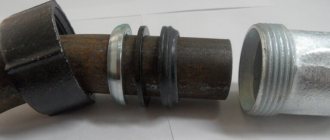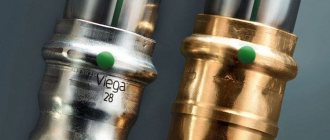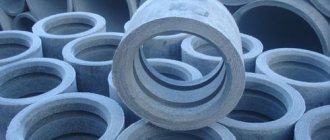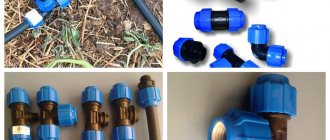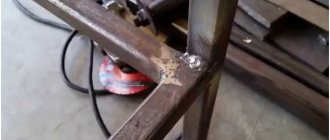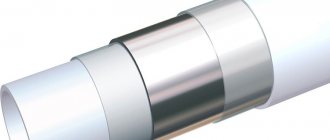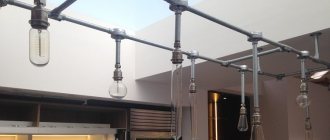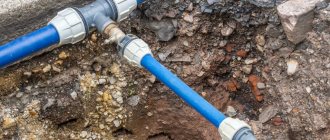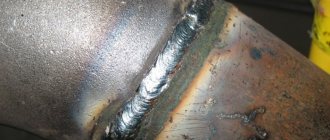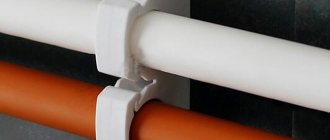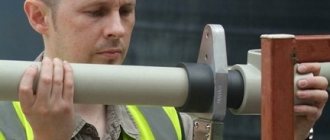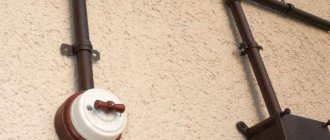When repairing and replacing apartment pipelines, or installing risers, not all connections can be welded. It is impossible to cut threads on a pipe that is close to the wall. For the joint, you will need devices for threadless connection of steel pipes.
Using them, they install main and process pipelines for transporting gas, oil, chemical reagents, and saturated steam. When connecting pipes without welding, the risk of corrosion damage to the joints is eliminated. The metal is protected by tightening linings; they form airtight joints.
Methods for connecting metal pipes without welding
Not all metals are welded well, and sometimes the quality of the seams is poor. Threaded joints are not tight enough, screw threads on metal are destroyed over time.
Weldless connections are technologically advanced. The devices are used on high-pressure gas pipelines when transporting heated media. To install seals, no preliminary preparation of joints or cutting of edges is required. It is enough to clean the ends from dirt and dust.
Methods for connecting metal pipes without welding:
- Clamp tie. A sealed, tight-fitting seal is used to seal leaks. Repairs can be done quickly.
- Flanged. The tightness of the plates is regulated by bolted fasteners, the tightness is ensured by a rubber gasket.
- Installation of the repair mounting clip. The joint is securely fixed in a small metal case.
- Using the Gebo coupling. The compression fitting is suitable for repeated use.
- Fastening fittings without threads. A permanent, hermetic connection of high strength is formed.
- Crab systems. Used for profile rolling.
For threadless connections, no special electrical or gas equipment is required; an installation tool is sufficient. To install the device, no technical training is required.
Advantages of crimp fittings
Industrial enterprises produce compression fittings with one or two ferrules, which are used to connect pipes without welding. As a result of the fittings being pressed during installation, if a section of the pipeline breaks, they will need to be cut off and replaced. Although this seems somewhat uneconomical, professionals still prefer to use these types of fittings. This commitment to this method of pipe installation is caused primarily by the fact that the elements of this design can be installed in places where it is impossible to reach either for welding or tightening threads.
In addition, among the main advantages of compression fittings are:
- absolute tightness of the connection without the need for welding or threading;
- high reliability of pipe joining;
- press fittings are able to withstand the vibration load of the pipeline for a long time.
In this regard, connectors of this type are actively used in metrology, gas turbine and compensating equipment, for piping instrumentation and automation devices and in pipelines operating under high pressure.
Connection using fittings
Mounting elements used in pipeline assembly vary in type and scope. Types of fittings:
- straight lines are intended for joining two system elements in the same plane;
- adapters are needed when connecting workpieces of different diameters; they are often necessary when repairing old pipelines;
- rotary, allow you to change the direction of flow;
- end caps are necessary when changing the pipeline layout;
- adjustable (tees, crosses) are needed when inserting into main lines or when installing bends;
- fittings – flexible fittings used when connecting to shut-off valves.
For fitting connections without threads, crimp or compression fittings are used. The design includes a sealing ring and is secured with an adjustable clamp. With the help of such fittings it is easy to connect pipes without welding. The joint is tightly and hermetically fixed on both sides. The strength of such a connection is superior to a welding seam. Fittings are used when installing pipes in technological systems where high pressure is created. They are used for plumbing and heating systems installation. No special equipment is required to fix the fittings. They are produced for plastic and metal pipes.
Mounting Parts
Connection without welding or threading is possible thanks to special parts - fittings. A fitting (from English “to mount”) is an element used in the following cases:
if necessary, connect two pipes without welding, including those of different diameters;- to rotate the pipeline route at a certain angle;
- for installation of pipeline branching.
Mounting parts designed to perform various functions have their own names. To connect pipelines of the same diameter, couplings are used; pipes of different diameters are connected by adapters.
To turn the pipeline route, bends having the required angle are used. A double branch in a perpendicular direction is made using a tee, and there are also crosses, fittings, plugs, and manifolds.
Fittings can be threaded or crimped. Since we are talking about pipe connections without welding and threading, the subject of consideration will be the relatively recently appeared compression fittings, otherwise called compression fittings.
Using the Gebo coupling
A special compression device will help you connect a metal pipe without welding. The Gebo coupling is a metal flange with a nut, inside of which there are three rings: a cone-shaped clamping ring, a clamping ring, and a sealing ring. To create a strong connection, it is important to adhere to installation technology.
Gebo coupling
The main stages of fastening the coupling:
- Preparation of the ends includes:
— alignment of the cut;
- cleaning of burrs;
— removing a layer of paint or enamel, removing the protective layer from galvanized pipes (the coupling protects the connection from oxidation).
- A nut and a clamping ring are put on one of the workpieces, with the upper part of the cone directed towards the nut.
- The Gebo coupling is assembled: a pressure ring is put on the sealing ring, then a sealing ring, it is turned towards the body, put on another pipe, and inserted into the body.
- The coupling is first compressed until immobile so that the nut does not turn. It is tightened, leaving several turns.
- Check the tightness of the joint. After this, the nut is screwed in completely.
Structure of the Gebo coupling
The coupling body is made of durable stainless steel or non-ferrous metal. The fasteners can be used after dismantling the pipeline; it is enough to replace the sealing rubber ring.
The use of the Gebo coupling is permitted on hot water supply systems. According to standards, the coolant temperature should not exceed +80°C. At high temperatures, the seal will have to be changed.
Single and double clamp and thread connections
A fitting with a one-way clamp is like half of the coupling described above. On one side the pipeline is connected, the other side is a branch with internal or external thread.
Where a tap or outlet can be screwed in. It is, in fact, a tee. The double clamp connection can be used to quickly install a perpendicular pipe bend without welding.
For the installation and repair of heating and hot water supply pipes, the company produces a full set of fittings equipped with elastic gaskets capable of operating at a temperature of +95°C.
All these fittings, like those described above, are universal and can be used to connect polypropylene pipes.
Gebo's range of fittings includes connecting devices for large-diameter main pipelines intended for underground installation. The connection of pipes in such pipelines can also be carried out without welding and threading.
Flange connection
Flanges are a thick disk with a central hole equal to the diameter of the pipe and side holes for bolting. Flanges are installed in areas that need to be inspected periodically:
- when inserting removable plugs, the flange is welded to them at the factory;
- for installation of metering devices (water meters, heat meters);
- installation of shut-off valves (various valves, taps).
Flange connection of metal pipes
A detachable threadless connection of metal pipes is formed by tightly fitting disks onto the edges of the pipes. When the plates are pulled together by a rubber ring gasket, a sealed butt joint is created that can withstand high pressure. The seal between the flanges on water pipes is replaced when leaks occur. When transporting hot or ammonia media (sewage) once every three to five years.
Plastic
If you need to assemble a plastic pipeline, you can use compression fittings, which work on the same principle as the Gebo coupling. Most often, metal-plastic and PVC pipes are connected in this way.
Compression fitting installation diagram
Also, sometimes special glue is used for these purposes. The installation process in this case is extremely simple:
- the joints are coated with special glue;
- then the parts are turned half a turn;
- They should be held in this position until the glue hardens.
It must be said that such a connection turns out to be quite strong, since the glue dissolves adjacent surfaces and, in fact, welds them.
Scheme for gluing pipeline parts
Compression fittings are also used to assemble metal-plastic pipelines. However, this requires a special tool that allows you to compress them.
To perform temporary repairs, you can also use the clamps described above.
These are, perhaps, all the most effective ways to connect pipes without welding, which I wanted to introduce you to.
Installation of repair and mounting clips
Strong non-welding joints are obtained by using special pipe linings that are pulled together. In fact, a repair and installation clip is a type of clamp. It is installed in emergency areas. The peculiarity of this method of threadless connection is its versatility. There are tee clips and crosses. The cast body in the form of two halves of the bushing is easy to install, just put the holder on the pipe, tighten 4 bolts - there are holes for them in the corner lugs. The tightness is ensured by a rubber seal - a piece of hose cut lengthwise.
Repair and installation clip
Clamps are used for process pipelines where leaks need to be quickly eliminated. They can be installed for a long period or until the next repair. Before assembly, the cast body is disassembled to create two halves. Place on the joint or fragment being repaired so that the gaskets fit the pipe tightly. After this, the bolts are inserted into the ears and the nuts are tightened on them. Clips are considered a consumable item by plumbers.
Set of repair and installation clamps for connecting steel pipes
Joining pipes using clamps, flanges and clips
The simplest devices for quick repair and joining of pipes are usually bolted and consist of two parts, which are put on the pipe and fixed in the right place using a rubber seal. An exception is the flange connection of gas pipes, which is bolted together through a rubber gasket in order to replace a section of the line.
Replacing metal and plastic sewer drains during repairs is also based on replacing damaged areas with the installation of rubber seals without tightening because there is no pressure in them. The main thing here is to prevent leaks, water flowing down by gravity and the appearance of odors.
A quick tap-in or repair using clamps and clips is not absolutely reliable, especially in systems with high pressure and temperature of the medium, and is a temporary measure. Clamps of various designs are one-piece or detachable pipe-like structures and are tightened through gaskets at breakout points using bolts.
They are designed to accommodate all pipe diameters up to 1520 mm and are available in single, double or triple. They are distinguished by quick installation on the damaged area, but require careful and consistent tightening of the bolts without distortions and deformation of the seals.
Connection using repair clips is more reliable because they are a cast body made of painted metal, consisting of two detachable parts. This method also uses a thick-walled rubber gasket, and both parts are connected with bolts.
Installation of clamps and clips is carried out in the following sequence:
- the emergency area must be thoroughly cleaned of metal shavings, irregularities, rust and other contaminants;
- if a clamp is applied, a rubber pad is wound around the damaged area and sealed;
- if a repair clip is installed, then a rubber seal is put on, the cut of which is lubricated with a silicone sealing compound;
- then the bolts are tightened sequentially and without distortion, in the case of a crosswise holder.
Repair clips allow for cross-shaped or T-shaped insertion, and are also used when connecting two sections of the pipeline.
During installation, it is important to avoid distortion of the seal, not to overtighten the bolts, and after supplying fluid under pressure, re-check the effectiveness of the repair and the tightness of the connection.
Application of clamps
Universal pads are put on cracks to eliminate leaks. They can connect pipes without welding threads. For tightness, sealing gaskets are used. Clamps are made of metal or dense sealed material. In terms of connection strength, clamps are comparable to welding. Overlay designs:
- wide and narrow in the form of split rings with holes for bolts;
- in the form of a metal bracket that secures a sealed gasket;
- complex geometry for fastening to a wall or two pipelines together.
Clamp for fastening metal pipes
Clamps for eliminating leaks are made from scrap materials. Fixed to the pipe with tape or wire.
There are many ways of mechanical connection. You can always choose something suitable for the situation. And the welding machine may not be available during the installation of a pipeline or metal structure.
Fastening professional pipes
Profile pipes used for the manufacture of load-bearing structures are most often connected by welding. In the event that such a pipe structure must be dismountable, it is necessary to connect the profile pipes without welding. For this purpose, various fasteners and clamps are used.
The so-called crab systems, which are shaped brackets stamped from sheet metal, have become widespread.
Crab systems allow various options for joining two, three and four profile pipes in different planes.
The angles formed by the pipes connected by such a system are always 90°. Using crab systems, it is convenient to assemble temporary structures from profile pipe elements, for example, scaffolding. The system is tightened using the threads of bolted connections.
HDPE pipe installation process
Despite the fact that the installation process of polyethylene pipes is quite simple, to create a durable and reliable functioning system, compliance with technical standards is required. To work, you will need a set of tools, pipes and connecting elements - fittings and accessories (tees, angles, plugs).
Tools
The set of tools for connecting HDPE pipes depends on how you are going to do it. When connecting pipes using compression fittings, you do not need any special tools other than a fine-toothed hacksaw or special cutters to cut the pipes into the required lengths.
When “hot” joining HDPE pipes, you will need a special electrical device - a welding iron. This device heats the ends of the pipe and couplings to the melting temperature, after which they are inserted into each other. You will also need special pipe cutters that allow you to quickly cut pipes at an angle of 90°.
Fitting
Connecting fittings for HDPE pipes come in two types:
- Compression.
- Diffusion.
Compression couplings are equipped with a threaded connection and rubber seals. The two halves of the coupling are put on the ends of the pipes being joined, after which they are connected with threads, forming a sealed joint. Diffusion couplings are used when welding pipes using a heating apparatus. Recently, electric couplings have appeared on the domestic construction market, connecting pipes by heating them with current. Electric couplings have terminal outputs on their surface that are connected to a special welding machine, which heats them.
DIY installation of HDPE pipes for water supply
Installation should begin from the water supply source - a well, a standpipe, or a main water supply. To speed up work and avoid possible errors, you should draw up a pipeline diagram in advance. In accordance with the scheme, the required number of pipes, additional elements and couplings should be purchased.
Country water supply from polyethylene pipes is easiest to install using compression fittings. The process will not take much time and does not require special skills. Compression couplings are first disassembled and screwed onto the pipe ends to be connected, installing the gasket and clamp. The connection is secured using an external clamping nut. When tightening it, do not use adjustable wrenches or other improvised tools. The nut should only be tightened using manual force to avoid damaging the coupling.
It is also possible to install the pipeline yourself using diffusion couplings. Here, for the connection, you will need a special device - an electric heater-iron, equipped with nozzles of the required diameter. The device is connected to the network, the heating relay is set to the desired temperature, after which the ends of the pipe and coupling are inserted into the heated nozzles. After melting the connecting ends, they are inserted into one another and fixed for one or two minutes.
It is also possible to solder HDPE pipes into joints, without using couplings. This happens with the help of a special end heating device equipped with holding devices. This method is usually used for large diameter pipes. When soldering pipes, you should ensure that the ends being connected are cleaned of dirt and moisture, otherwise the connection will not be airtight. When working with electric heaters, it is necessary to observe safety precautions, use special clothing and protective gloves.
Briefly about the main thing
Plastic pipes are made from three types of raw materials: polyethylene, polypropylene, polyvinyl chloride. Metal ones are made mainly from steel and copper, cast iron is less often used. Polypropylene and steel are most often used to install a heating system or water supply.
There are a number of ways to connect pipes made of different materials: using fittings, Gebo fasteners, flanges, clip lining, crab fasteners or clamps. Welding is only suitable for joining homogeneous materials, but if a metal tip is put on a plastic pipe, then this method can also be used.
All of the methods listed are not homemade and the components for their use are freely available. The main thing is to understand the system itself and purchase the necessary fasteners of the appropriate size.
Ratings 0
A little about pipes
Before connecting metal and plastic pipes, you should consider them separately.
Most often, pipes made of cast iron, steel, copper and plastic are used for heating and sanitation in premises. Copper ones are “softer” to process, but they are also more expensive, so they are not widely used.
Metal ones are divided into the following subspecies:
- Steel . They are often susceptible to corrosion, and the internal diameter only becomes smaller as it becomes overgrown with rust or plaque, which leads to the need for frequent replacement or cleaning of the system.
- Galvanized . A very difficult material for assembling or installing a pipeline, but its main feature is that galvanized pipes are less susceptible to corrosion and build-up.
- Stainless steel . It is quite difficult to process, and the market value is the highest of all.
Coupling connection between metal and plastic Source san-kras.ru
Plastic pipes are made from the following materials:
- Polyethylene . It is very soft and flexible, but is unsuitable for high-temperature water - at +80 °C the material begins to deform and leaks appear.
- Polypropylene . It can easily withstand water temperatures up to +90 °C, which allows the use of such pipes even for heating systems. Polypropylene is lightweight, which makes its installation convenient.
- Polyvinyl chloride . It is used for the production of sewer pipes, since this material is unsuitable for heating and water supply.
On a note! The coolant temperature in heating systems does not exceed 85 °C, and if there are no severe frosts, then about 60 °C is sufficient, and for heated floors 25–35 °C.
Plastic pipes with adapters Source stroikairemont.com
Features and characteristics of connected pipes
In an apartment or private house, different types of rolled pipes are used. In apartment buildings, rolled steel was traditionally used to transport water. Now it is replaced with plastic or metal-plastic, less often with rolled copper. The sewer system was made of cast iron.
READ ALSO: How to connect asbestos pipes: couplings for asbestos-cement pipes with plastic pipes, connecting each other with a metal pipe
Pipe installation often involves inserting into a system made of dissimilar materials. It is impossible to connect such areas by welding - they have different melting temperatures. Fastening adapters are available with or without threads, acting as seals.
Required tools and accessories
- A plastic cuff that has a transition from the existing diameter to the desired one.
- Plumbing sealant.
- Cuff lubricant. You can use household liquid soap.
- A flat-head screwdriver, a hammer and some kind of lever. As the latter, you can use a piece of metal pipe or a wooden beam.
To decide how to dismantle a unit , for example, a shower stall in a small bathroom (see design), you need to know how the connection of cast iron pipes works. A heel must be inserted inside.
This is a linen thread impregnated with an antiseptic.
Cement or sulfur-based mortar was used to ensure sealing.
If the joint is on cement, you need to carefully knock out all the cement from the joint by lightly tapping it with a hammer on a screwdriver.
Typically, the layer thickness is no more than 0.5-1 cm.
If the connection is made using sulfur, you will need a gas burner.
The simplest household one, based on a gas can or a blowtorch, will do.
If there is no burner on the farm, you can go another way.
The pipe is cut along the edge of the joint, and the solution is drilled out with a thin drill.
Then it is removed using a screwdriver or a small chisel. But this method is more labor-intensive, and it is better to purchase a gas burner.
The flame of the burner evenly heats the pipe and the visible part of the solution.
At the same time, a very unpleasant and persistent odor can be released from the siphon under the kitchen sink.
Therefore, it is imperative to ensure ventilation of the room, and it is necessary to work in a gas mask or coal respirator.
When heating, ensure uniform heating of the sulfur and the pipe itself.
If you direct the flame to one point for a long time, the pipe may crack due to the temperature difference.
In some places, sulfur begins to leak out, but this is not a necessary condition.
It is enough to soften it throughout the entire mass.
The softened sulfur is gradually picked out from the connection , while at the same time trying to rock the pipe being removed. If the tee is removed, it is convenient to turn it using a lever.
It is better to do this work together - one loosens the pipe or tee, the other pushes it to the side.
After removing the unnecessary section of the pipe , the socket must be thoroughly cleaned of cement and dirt residues.
From the outside, this can be done by lightly tapping with a hammer, and from the inside - using a screwdriver or thin chisel.
If the heel is very strongly stuck to the surface of the pipe, you can use a wire brush to remove any remaining residue.
Do not forget to immediately plug the pipe hole behind the socket with a rag or cellophane bag.
If this is not done, drains drained from above may come out.
And we need to not only clean the internal surface of the joint well, but also thoroughly dry it before applying the sealant.
Yes, and it is advisable to block the odors coming from the sewer.
A layer of sealant is applied to the cleaned and dry surface of the socket.
It is advisable to also apply a small layer on the outer surface of the cuff, in each of its grooves.
Then the cuff is inserted into the pipe, and with light blows of a hammer it is driven as deep as possible.
There is no need to use sealant inside the cuff . A layer of plumbing silicone grease or liquid soap is applied to its inner surface.
Do not use grease, lithol or machine oil for this. Under their influence, the rubber may decompose over time, and the cuff will become unusable.
Next, a new plastic pipe is inserted into the cuff. It happens that even when using lubricant, it fits into the cuff very tightly.
In this case, the opposite edge of the pipe can be lightly tapped with a hammer.
In this case, it is necessary to use a spacer made of a wooden plank or plywood so that it covers the entire width of the socket.
Types and design of shut-off valves
Fittings for plastic water pipes are classified depending on their purpose, design, area of application, operating conditions and method of fastening.
The choice of device is influenced by the material of manufacture - it must be suitable for installation on a specific highway. Depending on the specific application, the following types of fittings are distinguished:
- Constipated. This class of products is the most numerous - it accounts for ¾ of all devices used. Used to completely shut off the flow of media in the line and start it up if necessary. Locking products include gate valves, taps and valves. They are used to regulate the movement of various media - gas, steam, water.
- Regulatory. Devices of this type of shut-off valves for water supply systems have valves and are called liquid, pressure, and medium level regulators. They move due to the operation of an electric drive. One of the common names for such models is throttling valves.
- Safety. Thanks to these devices, communications for various purposes are protected from pressure exceeding permissible values. If this indicator becomes higher than normal, a partial reset of the working environment occurs. Safety valves include bursting discs, bypass valves, and impulse devices.
- Protective. The main importance of such mechanisms is to prevent accidents and breakdowns when technological process parameters are unacceptable for the main line. In addition, the mechanism prevents the flow of the working fluid in the opposite direction. Safety valves include shut-off and check valves.
- Distribution and mixing. It has another name - multi-pass. Such devices include distribution valves and three-way valves. The products are used for mixing media or distributing work flows in several directions.
- Test. Designed to monitor and regulate the liquid level in boilers and vessels.
- Phase separation. Used to separate work environments in different states. Such devices include condensate drains and oil separators.
Flange valves
Based on the connection method, devices are divided according to the following classification:
- Flanged. This type of fittings is presented in round, rectangular and triangular models. Square devices are designed for environments with limited pressure levels - no higher than 2 atmospheres. The round shape is more preferable - its production requires a minimum of resources, and in terms of reliability it is superior to other types.
- Waferless. The range of offered products of this type is quite extensive in terms of methods of connecting it to pipelines, pipes of containers and vessels. Models in this group can be pin-type, fitting-type, welded-type and coupling-type.
Shut-off valves are installed on HDPE, metal-plastic, polypropylene and stainless steel lines.
A few important points when welding
A tool such as a professional soldering iron is expensive. Therefore, it is more profitable to buy inexpensive options if you have to do a one-time job. “Amateur” models are usually equipped with several running attachments. An even better solution would be to rent a tool. The quality of the connections will not be affected in any way.
Before connecting the soldering iron to the network, the parts of the nozzle are placed on the device when it is cold. They begin to work with the tool after the indicators on it go out.
Warm-up time depends on several factors:
- type of pipe products;
- wall thickness;
- diameter of the connected structure.
All of the above parameters, as a rule, are available in the table attached to the soldering irons.
